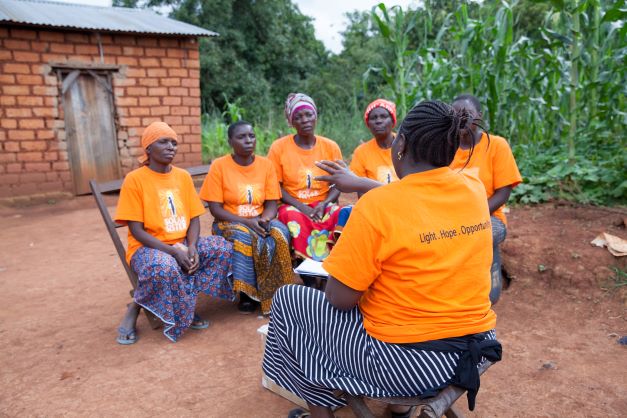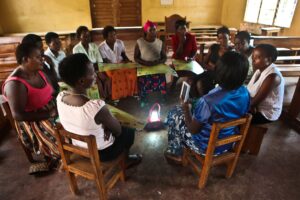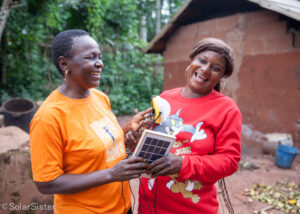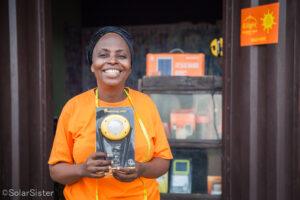GDC member spotlight: Solar Sister

In summer 2020, Solar Sister embarked on a pilot project financed by EEP Africa, and in partnership with CLASP, EST and Global Distributors Collective, to test the sale of productive use of energy (PUE) products through their women-centric sales network in Tanzania. At the wrap-up of the project, we caught up with the Solar Sister team to reflect on what they learned along the way…
To find out more about 13 leading GDC members’ experiences of piloting and selling PUE and how the wider sector can work closely with last mile distributors (LMDs) to enable underserved people to benefit from income and productivity gains from PUE, check out our blog and report: Selling productive use of energy products at the last mile: Lessons learned.
Why did you want to test PUE products with your customers in the first place?
Our bread-and-butter is cookstoves and small scale off-grid solar products (lights, solar home systems, phone chargers and radios), but we wanted to see if we could get appliances with greater income-generating potential into the hands of last mile customers. We also felt that selling higher value productive use of energy (PUE) products in their own communities could help Solar Sister Entrepreneurs to increase their income, so it was a potential win-win for our sales teams and customers alike. Diversifying our product basket, particularly during Covid, also seemed like a sensible move.

An ongoing mentoring session
How did you go about selecting the PUE products?
We added nine new PUE products to our offering, which was undoubtedly too ambitious (more on that later!): fishing lights, egg incubators, sewing machines, barber kits, entertainment packages, phone charging hubs, security lights, water heaters, and a large portable lantern that fishermen told us they used to keep their businesses open later at night. We conducted a needs assessment with Solar Sister Entrepreneurs – who we felt, by proxy, represented a customer base who we found it difficult to interact with during the pandemic – to better understand which PUE product categories customers would be interested in. However, because we had not yet managed to identify specific suppliers and products, we weren’t able to ascertain customers’ willingness to pay particular prices or to take out a loan to cover the costs. While initial demand therefore appeared to be high, it did not convert into sales – in the end, we sold 2,910 products over 18 months, whereas our original goal had been to sell over 5,000.
The sales were not what you hoped for. What were the key barriers?
The under-developed supply chain in Tanzania. Our main challenge in selling PUE products was with the under-developed, overly-expensive, and, in some cases, unreliable supply chain in Tanzania. There is a chicken-and-egg situation at play here: when suppliers don’t see the market demand, they understandably don’t invest in building reliable supply chains – but without these in place, even limited demand can’t be met. For many PUE products, we either couldn’t get our hands on a sample to show customers, or it took several months to get samples into the country; and when they arrived they’d be at exorbitant prototype pricing. The distribution side was hard enough, but the rest of the supply chain is also still underdeveloped.
The difficulty in providing consumer financing. Our customers need access to loans with affordable interest rates but these are hard to come by, so we sold some products on a referral basis, whereby the supplier provided the credit. We also piloted our own consumer credit mechanism, but the products’ wholesale costs were so expensive that only three customers applied for Solar Sister credit. When the interest rates were added onto the base price, last mile customers – who are already risk averse, particularly when it comes to unfamiliar products – were even further discouraged from buying. More work is needed to educate customers around the business case for investing in PUE products so they understand the benefits of taking out credit for these products. Additionally, there need to be more and better financing options for consumers, and base prices on PUE products need to come down.
Inability to provide comprehensive aftersales service. PUE products are more complex than small-scale off-grid solar products and require a certain level of technical knowledge and bespoke support. We don’t have the technical capabilities to provide after-sales service (specifically for repair) on many PUE products. And we found that suppliers would not put a person in-country for this purpose unless we could demonstrate the market demand – but we couldn’t drum up demand without being able to assure customers that we could service the product. Suppliers who were not in the country were unwilling to bear the shipping costs related to repairing faulty products; nor were they willing to give us extra products to have on hand, in case of warranty issues. Without having replacement products on hand, customers ended up waiting a long time for warranty issues to be successfully resolved, which further stymied demand. Ultimately, without a strong aftersales offering, the trust in and sale of products is compromised. On top of that, poor after-sales service is also a credit issue. When a PUE product breaks it means the customer is either unable to generate the income required to pay the product loan off, or will simply refuse to repay instalments. Whoever is providing the financing therefore also risks losing out.

Happy faces during a sisterhood meeting
What is your top tip for other last mile distributors wanting to learn from your experience, to effectively sell PUE products?
Don’t bite off more than you can chew! In hindsight, we tried to do too many things at once. We should have picked just one product and run with it, rather than trying to sell an entirely new range in one go. This was challenging, not just in terms of getting our hands on so many different products from many different suppliers, but also in training our staff and Solar Sister Entrepreneurs to sell multiple new products with entirely different offerings… while also introducing a different sales and financing approach compared to what they were used to. This was information overload! It is better to take the time to understand deeply where and how one product will sell before moving on to the next one. Moving forward, we will listen to field staff and entrepreneurs to really understand which products are in demand by customers, and then from there seek to identify one product at a time – creating relationships with reliable suppliers – to test in the field. . Narrowing our attention in this way will give Solar Sister Entrepreneurs the chance to master selling a single PUE product, help to build their confidence, and hopefully lead to more sales.
What do other players across the value chain need to do to make PUE products accessible to last mile consumers?
Focus more on developing the ecosystem for PUE products rather than just the technology. Too much time and money is spent iterating the technology. Of course investing in technology R&D is important to ensure products are appropriate and affordable for last mile consumers. However, there also needs to be investment in the business models, distribution and financing expertise required to get it into the hands of last mile customers (and making sure it works). LMDs also need support from suppliers to educate customers about PUE and financing options and to stimulate market demand.
Try to understand the realities of operating in last mile markets. Manufacturer-distributor partnerships are a unique opportunity for other stakeholders to leverage the proximity that distributors have to customers and our long-term presence in communities to deepen their understanding of last mile markets; as this is important to inform the design of products, credit mechanisms, and so on.
To reach underserved markets, be willing to share an element of the risk with your partners. We do not expect our customers to absorb distribution costs or the hidden costs of developing a nascent supply chain. But if those costs can’t be passed on to the consumer, who is going to cover them? It’s important for all three key players – financiers, distributors, and suppliers – to take on a small amount of risk to make it manageable. LMDs cannot successfully sell PUE products by taking on the risk alone.

Rachel showing a product by Solar Sister
Finally… was it worth it?
Despite the challenges, we definitely believe it was worth it! Pilots are always going to have issues, but for us the value was in using real-time data from the field to understand what does and doesn’t work, and being able to share that with other distributors to learn from. We were fortunate that our pilot was funded by a donor (EEP Africa) who shares our openness to learning. We hope that our experience can shed light on some of the challenges in selling PUE products at the last mile, and enable other distributors to more quickly adapt their approach to help underserved customers gain the potentially transformational benefits that PUE products can bring.
The world of PUE is what the world of off-grid solar lighting was ten years ago; and we’re not going to move it forward at the speed required without organisations like ours testing, iterating and sharing.
The GDC member spotlight series is supported by GET.invest, a European programme which aims to mobilise investment in decentralised renewable energy, supported by the European Union, Germany, Norway, the Netherlands, Sweden and Austria.
Photo credits: Solar Sister
